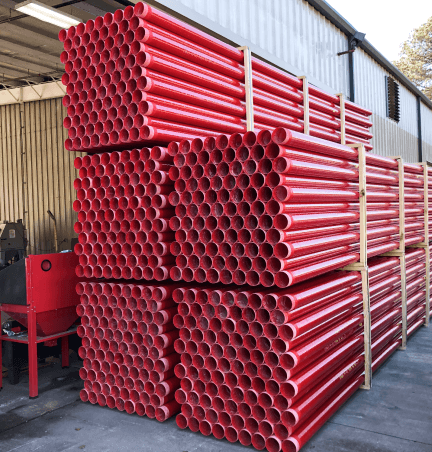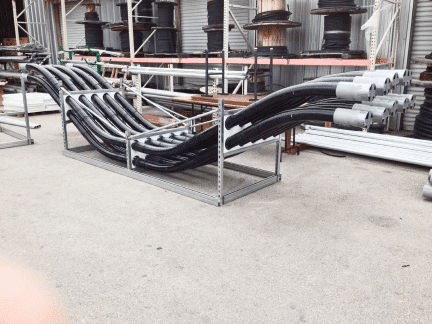As engineers and project managers have increasingly discovered, all fiberglass conduit is not created equal. When it comes to choosing a phenolic conduit, there is a range of safety considerations that deserve a closer comparison, specifically around harmful chemicals, including formaldehyde. The construction industry offers several recent examples of the repercussions of using chemically unsafe materials. What do you need to know before you choose a phenolic conduit for your next tunnel, rail, or transit project? Here, you’ll find a few enlightening examples, useful product information, and ways to increase safety and savings with Champion Flame Shield® Phenolic conduit.
Formaldehyde – What You Should Know
Uses
Formaldehyde is a common component of many building materials, including many phenolic resins and melamine resins. It’s used as a binding agent in many paper- or composite-wood-based building products; it is also used in fiberglass insulation, and in all phenolic fiberglass conduit except Champion’s Flame Shield®.
The Cost
Two recent examples perfectly illustrate the dangers of building without carefully monitoring materials’ formaldehyde levels. During both Hurricanes Rita and Katrina, FEMA deployed temporary trailer housing for displaced residents – thousands of trailers in all. Later, government testing of trailers found that the epoxy used contained formaldehyde levels that were up to five times of those present in most modern homes. It is alleged that hazardous fumes led to health problems for the trailer’s residents; as a result of class action lawsuits, more than $50M is being paid to defendants by over 20 trailer manufacturers.1
In 2016, a hardwood flooring retailer, was featured on a 60 Minutes segment highlighting a laminate flooring sold by the outlet. The product, made in China, had higher-than-allowed formaldehyde levels. The Centers for Disease Control reported that those exposed to the flooring’s epoxy were three times more likely to get cancer, and profits plunged – the company pled guilty to environmental crimes, eventually paying $13M for illegally importing hardwood flooring.2
Regulations
Many industries set forth regulations around acceptable levels of formaldehyde, and the construction industry is no different. The construction industry consumes 60 to 70 percent of the formaldehyde produced in the United States, and safety concerns around usage have prompted stringent regulations, including the 2010 Formaldehyde Standards for Composite Wood Products Act.3 It is a reasonable assumption that these standards could soon extend to other composite materials.
Future
Formaldehyde has been targeted for reduction in many applications, and for elimination in the state of California. Formaldehyde is not only recognized as a human carcinogen, but has been known to cause contact dermatitis, and eye, nose, and respiratory tract irritation. Phenol formaldehyde, the form used in the manufacture of all non-Champion fiberglass phenolic conduit, is listed as a suspected immunotoxicant by the National Institution of Health.4
The Champion Fiberglass Answer. Formaldehyde-Free Phenolic Conduit.
Champion’s Flame Shield® Phenolic Conduit is not manufactured with a condensation reaction of phenol and formaldehyde. Therefore, it does not generate residual corrosive byproducts, eliminating emission of formaldehyde and toxic halogens during installation or when burning.
This increases the safety of those cutting and installing the conduit on-site (fewer irritants, less risk of contact with carcinogens). It also contributes to increased safety during a catastrophic event – beyond freedom from dangerous emissions, this conduit can be exposed to temperatures up to 1,850°F for two (2) hours, and conforms to NFPA 130 requirements; it is also OSHA compliant.
Champion Fiberglass Flame Shield® Phenolic Conduit is the only fiberglass conduit that can offer savings, the security, and peace of mind. That allows you to spec for success – and for unmatched safety.
Footnotes:
- Cbs/ap. Lumber Liquidators Profits Plunge over Product Safety Fears. CBS News, CBS Interactive, 29 Feb. 2016, www.cbsnews.com/news/lumber-liquidators-laminate-flooring-cancer-risk/.
- Gates, Jimmie E. FEMA Trailers Brought Shelter, Problems to Katrina Victims. USA Today, Gannett Satellite Information Network, 29 Aug. 2015, www.usatoday.com/story/news/nation/2015/08/28/fema-trailers-brought-shelter-problems-katrina-victims/71342988/.
- The Benefits of Formaldehyde in Construction. Building With Chemistry, buildingwithchemistry.org/chemistry-in-bc/formaldehyde-in-building-and-construction/.
- Formaldehyde Found in Building Materials. Healthy Building Network, May 2008, s3.amazonaws.com/hbnweb.dev/uploads/files/formaldehyde-found-in-building-materials.pdf.
Keep Reading
Champion Fiberglass® Named a CompositesWorld Top Shop for 2024
The origins of fiberglass date back to the ancient Greeks. Today fiberglass is used for a variety of applications from…
Get to Know Research and Development Engineer Blake Rogers
He’s got a diverse background in engineering, is new to Texas and can juggle. Meet Blake Rogers.
Electrical Conduit Cost Savings: A Must-Have Guide for Engineers & Contractors
To help identify cost savings that don’t cut corners on quality, Champion Fiberglass developed a free resource for engineers and…










